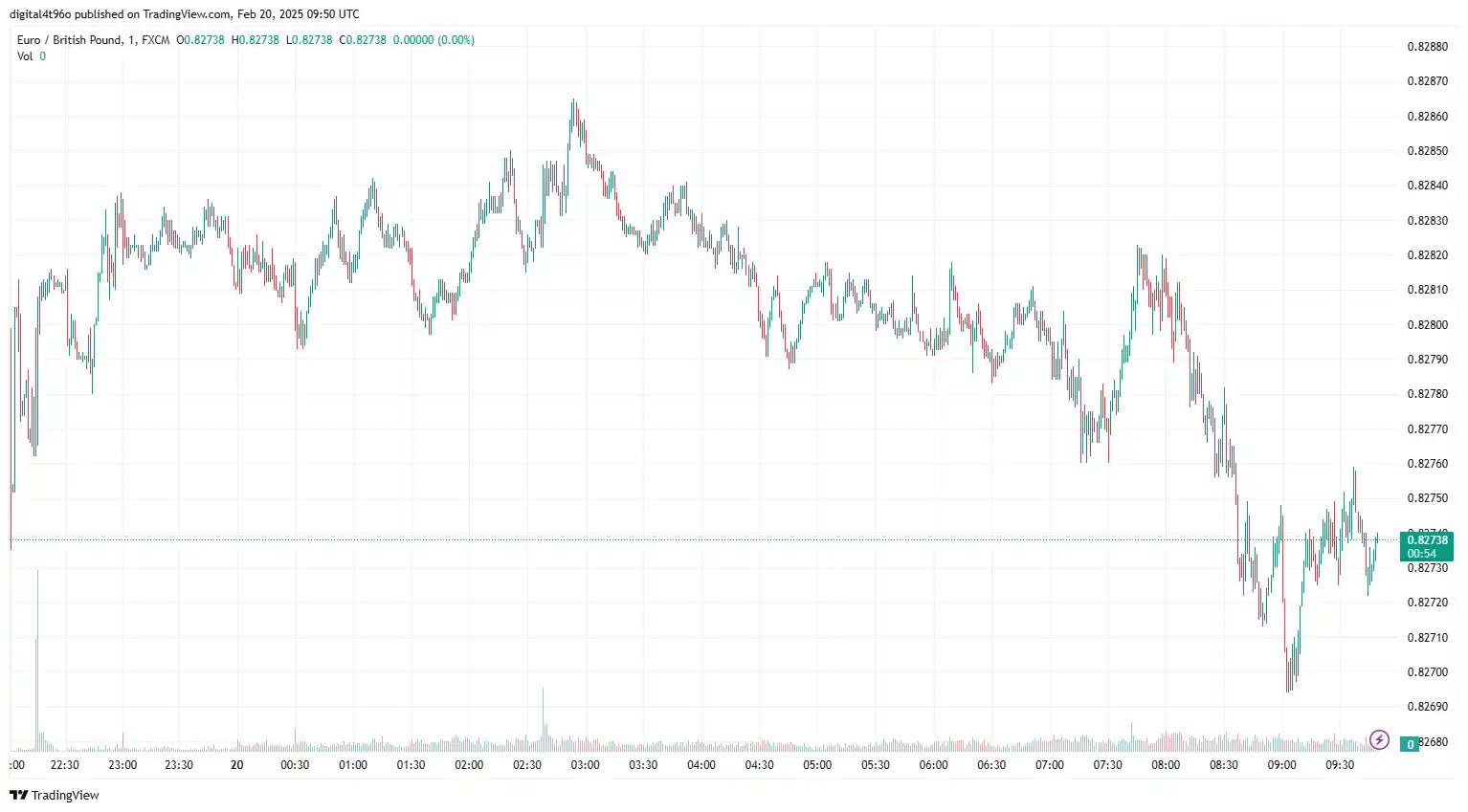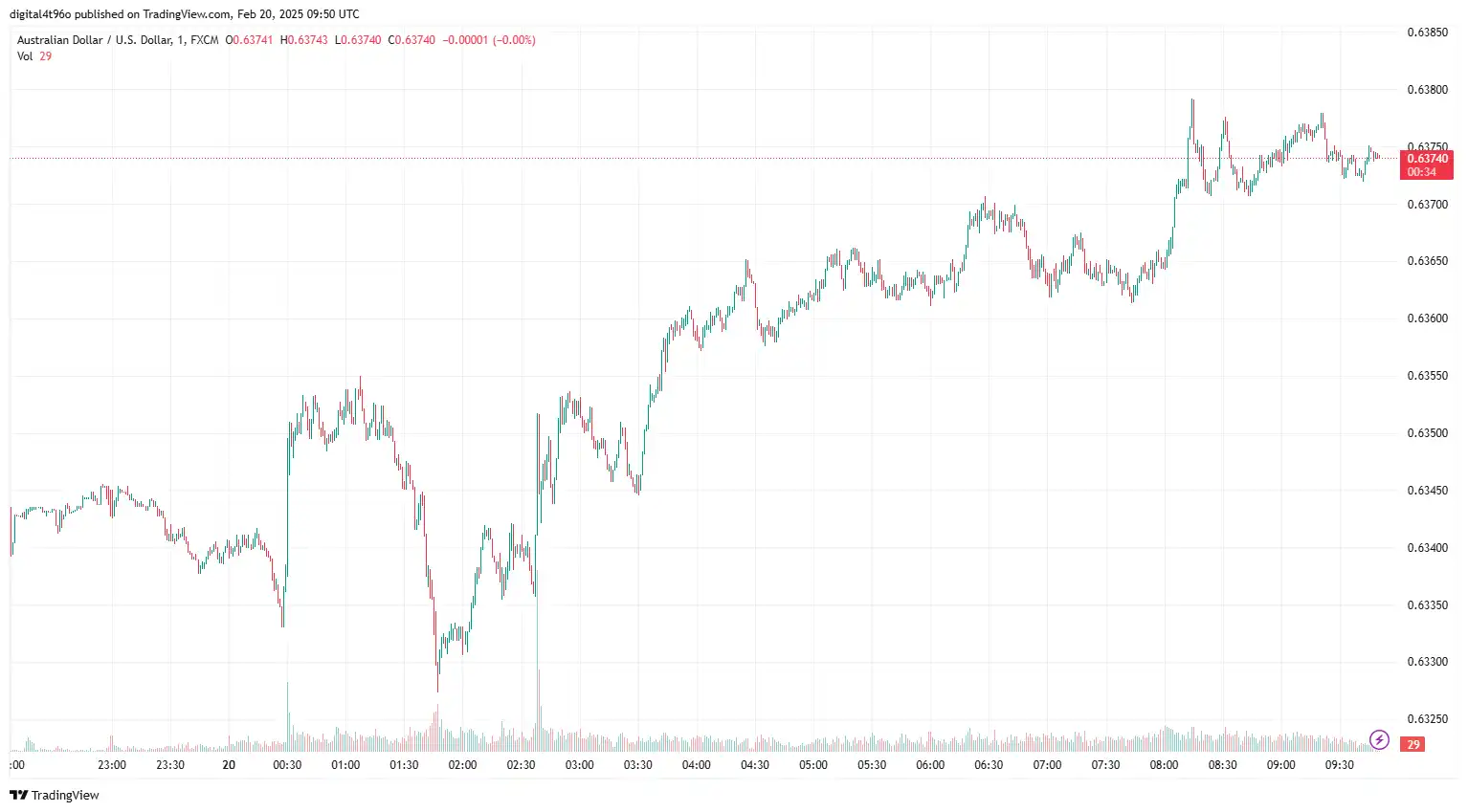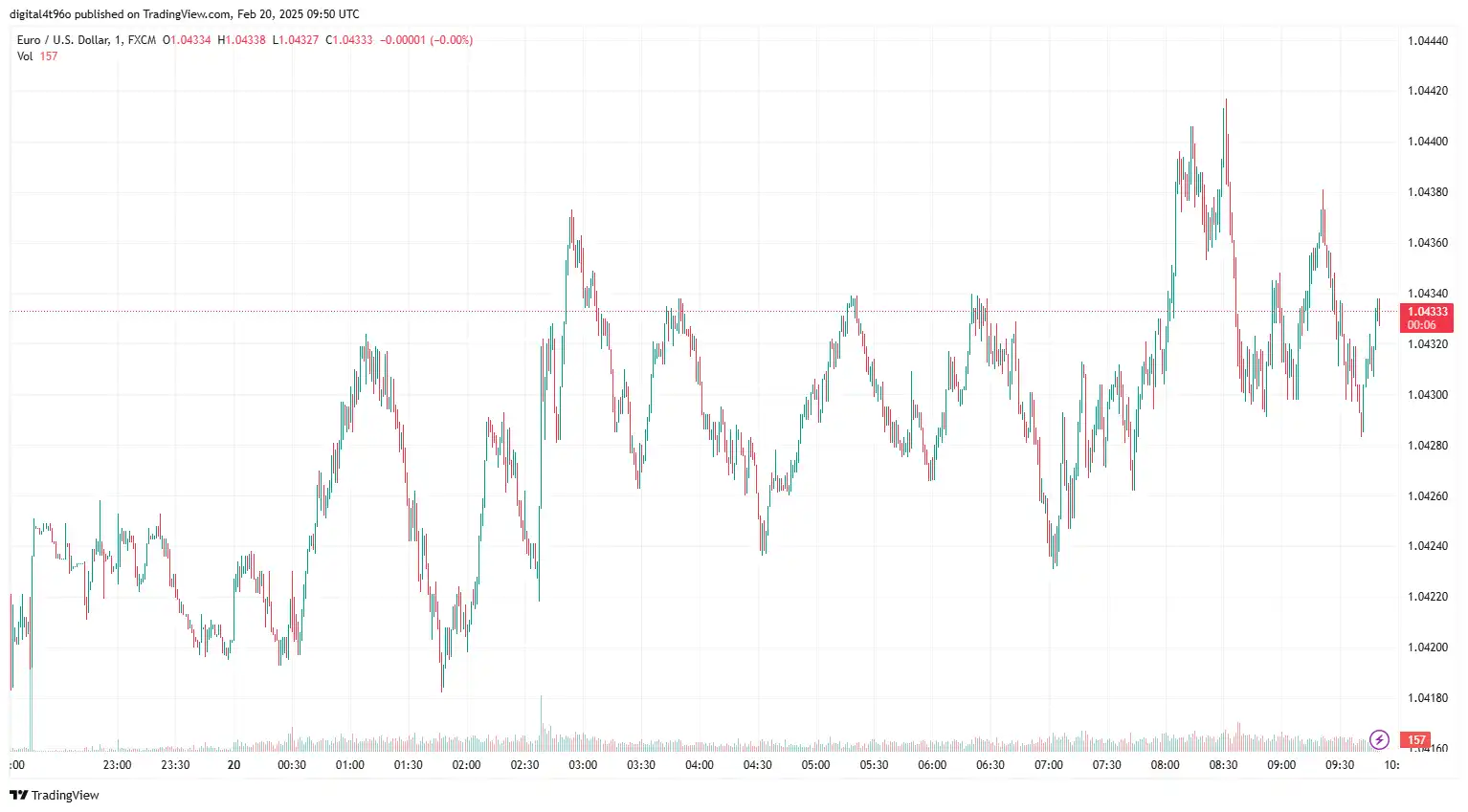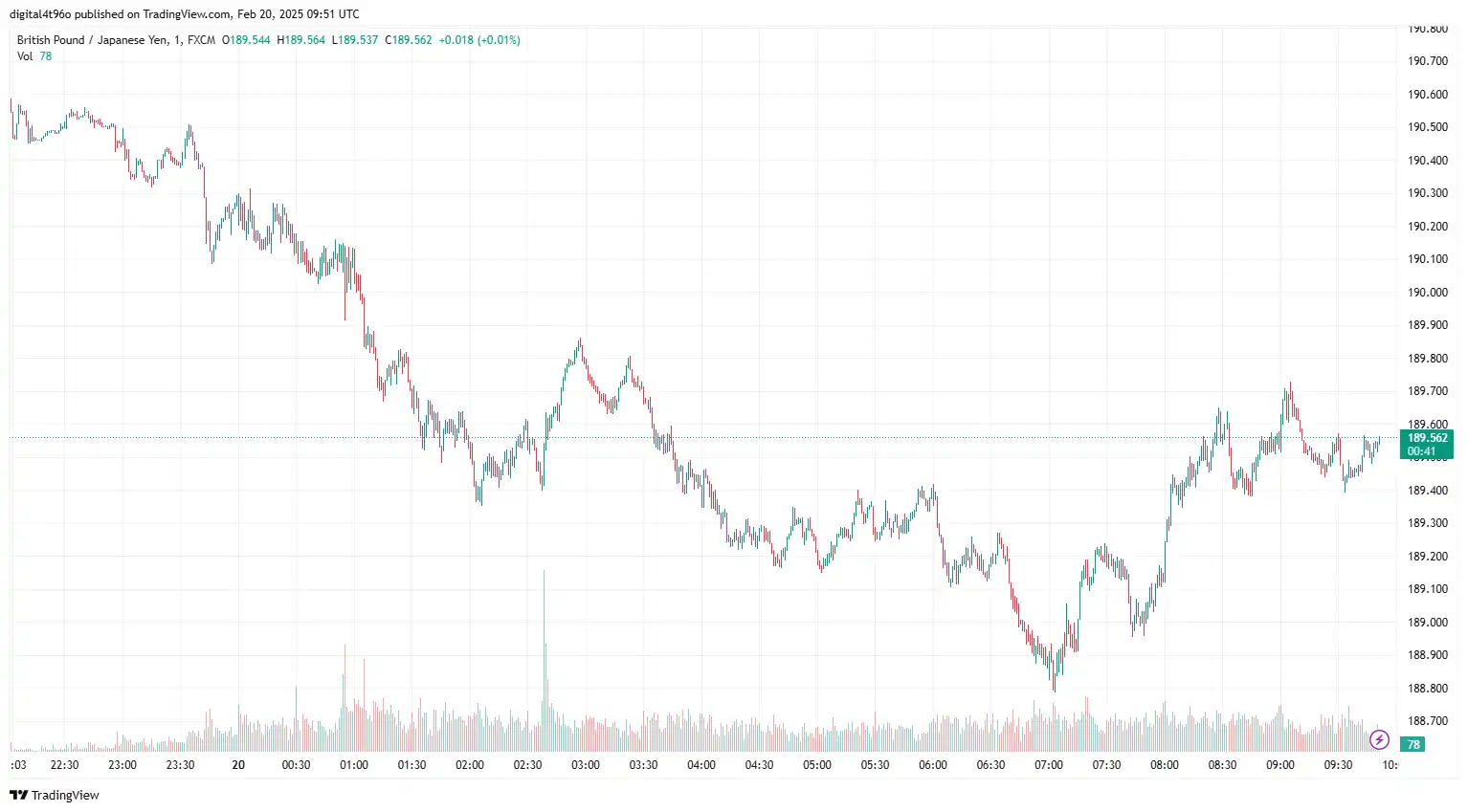EUR/GBP softened near 0.8275 following the release of hotter-than-expected UK Consumer Price Index (CPI) inflation data. In January, the Consumer Price Index (CPI) experienced a notable rise of 3.0% year-on-year (YoY), up from 2.5% in December and surpassing market expectations of 2.8%. Monthly, CPI inflation dipped into negative territory, falling to -0.1% from +0.3% in December—outperforming the predicted -0.3%. Core CPI, which excludes the more volatile food and energy prices, increased by 3.7% YoY, aligning with expectations and reflecting an uptick from the previous month's 3.2%. Similarly, services inflation surged to 5.0% YoY, up from 4.4% in December. Despite this modest improvement in price levels, inflation remains stubbornly above the Bank of England's (BoE) 2% target, constraining the central bank's ability to ease monetary policy further.
BoE Governor Andrew Bailey acknowledged the UK's uncertain economic outlook, describing it as a "period of heightened uncertainty" with weak growth. The ILO Unemployment Rate for the three months to December held steady at 4.4%, outperforming the expected rise to 4.5%. However, the Claimant Count Change rose by 22K in January, contrasting with the previous month's decline of -15.1K and missing the anticipated 10K increase. Wage growth remained robust, with Average Earnings Excluding bonuses increasing to 5.9%, up from 5.6%. Average Earnings, Including bonuses, also rose by 6%, exceeding both the forecast of 5.9% and the earlier 5.6%. This wage growth indicates ongoing inflationary pressures, reinforcing the BoE's cautious outlook ahead.
Sluggish growth in the Eurozone, coupled with mounting expectations of further interest rate cuts by the European Central Bank (ECB), has put downward pressure on the euro. The Eurozone's ZEW Economic Sentiment Index came in at 24.2 for February, showing an improvement from January's 18.0 but still falling short of market expectations of 24.3. In terms of trade, the Eurozone recorded a €15.5 billion surplus in goods trade for December 2024, down from €16.4 billion in December 2023. Exports from the Euro area grew by 3.1%, reaching €226.5 billion, while imports saw a slightly larger increase of 3.8%, totalling €211.0 billion. Today's Producer prices in Germany rose by 0.5% in January, driven mainly by a 3% increase in non-durable consumer goods prices, including a 3.5% rise in food prices. Durable goods prices climbed by 1.1%, while capital goods saw a 1.9% increase. However, energy prices fell by 1.0% year-over-year and dropped by 0.9% compared to December. The overall monthly index declined by 0.1%.
Broader market sentiment around the Eurozone Current Account and the latest industrial trends orders index numbers will drive the EUR/GBP exchange rate.

AUD/USD Buoyed Following Australian Employment Data
The Australian Dollar (AUD) edged higher against the USD, trading near 0.6372, following the labour market data. On Thursday, Australian Bureau of Statistics (ABS) data revealed that the unemployment rate rose to 4.1%, up from 4.0% in December, matching the market expectation of 4.1%. The Australian Employment Change was reported at 44,000 in January, down from 60,000 in December (revised from 56,300), compared with the consensus forecast of 20,000. The participation rate in Australia increased to 67.3% in January, slightly higher than December's 67.2% (previously revised from 67.1%). Meanwhile, full-time employment rose by 54.1K, a recovery from the decline of 23.7K noted in the previous report. In contrast, part-time employment fell by 10.1K in January, compared to a decrease of 83.7K earlier (revised from 80K).
On Tuesday, the RBA reduced its Official Cash Rate (OCR) by 25 basis points to 4.10%, consistent with market expectations, marking the first rate cut in four years. After the policy meeting, RBA Governor Michele Bullock acknowledged the effects of high interest rates but stated it was too soon to declare victory over inflation. She also emphasised the unexpectedly robust job market, clarifying that the expectation of further rate cuts is not guaranteed. Additionally, the People's Bank of China's (PBOC) decision to maintain one-year and five-year Loan Prime Rates (LPRs) were at 3.10% and 3.60%, supporting Aussie. President Trump renewed the cautious market sentiment on the geopolitical front with comments, "I probably will tell you that on April 2, but it'll be in the neighbourhood of 25 per cent. It'll be 25 per cent and higher, and it'll go very substantially higher over the course of a year."
The US dollar gains as the Federal Reserve's (Fed) policy stance drives risk-off flows, generating demand for the safe-haven currency. On the economic front, the Empire State Manufacturing Survey showed that the headline General Business Conditions Index rose eighteen points to 5.7 from -12.6 and against the predicted -1.9.
In today's session, the possibility of a trade deal with China and a summary of the FOMC Meeting Minutes will drive the AUD/USD's movements.

EUR/USD Weakens Amid Geopolitical Uncertainty
EUR/USD edges lower near 1.0431, as tariff concerns stemming from the latest Trump remarks undermine the euro. Trump stated that he would likely impose tariffs of approximately 25% on foreign cars, while semiconductor chips and pharmaceuticals are expected to face increased duties. Trump did not offer a clear timeline for when these tariffs would take effect but mentioned that some of them would be implemented by April 2. Recent remarks from key Fed officials continue to influence the greenback's movements. Fed's Vice Chairman Philip Jefferson stated, "Fed can take time when weighing the next monetary policy move as US economic performance has been quite strong. The US labour market is solid, and inflation has eased but is still elevated. Fed's Chicago President Austan Goolsbee commented, "Inflation has decreased, but it is still excessive. Once inflation falls, rates can fall more," hinting at further rate cuts.
However, the US Dollar strengthened due to the cautious outlook emerging from the January Federal Open Market Committee (FOMC) Minutes. Federal Reserve (Fed) officials reiterated their decision to maintain steady interest rates in January. They emphasised the need for additional time to assess economic activity, labour market developments, and inflation trends before contemplating any rate adjustments. Furthermore, the committee agreed that signs of falling inflation are necessary before any rate reductions occur.
On the other hand, rising expectations that the European Central Bank (ECB) will continue rate reduction, weighs on the euro. Yesterday, European Central Bank (ECB) policymaker Fabio Panetta signalled economic weakness in the Eurozone, stating, "We anticipated a recovery driven by consumer spending, but that has not materialised." This followed remarks by US President Donald Trump, who appeared to blame Ukraine for the conflict with Russia, leading to a sharp response from Ukrainian President Volodymyr Zelenskyy. In upcoming sessions, the Eurozone's Flash Manufacturing PMI & Flash Services PMI, US weekly Initial Jobless Claims, the CB Leading Economic Index and the Philly Fed Manufacturing Index reports will shape the market sentiment around the EUR/USD exchange rate.

GBP/JPY Struggles on BoJ Rate Hike Bets
The Japanese Yen gained against the pound, approaching 189.69, as the Bank of Japan (BoJ) increased its likelihood of raising interest rates further, raising Japan's bond yields. On Wednesday, BoJ Board Member Hajime Takata stated that the BoJ must gradually adjust its policy, even after January's rate hike, to prevent upside price risks from materialising. On the economic front, Japan's core machinery orders, excluding ships and electric power, fell by 1.2% month-on-month in December 2024, contrasting with the previous month's increase of 3.4%. This decrease was below the anticipated gain of 0.1%, marking the largest decline in four months. Meanwhile, Japan's trade deficit widened sharply to JPY 2,758.78 billion in January, up from JPY 1,766.54 billion a year earlier, surpassing market forecasts set at JPY 2,100 billion. Imports surged by 16.7% year-on-year, reaching a 26-month high, significantly exceeding December's growth of 1.7% and outstripping expectations of 9.7%. Conversely, exports grew more slowly at 7.2% year-on-year, marking the fourth consecutive month of growth but falling short of the anticipated 7.9%. The Japanese economy grew by 0.7% in Q4 2024, up from a revised 0.4% in the previous quarter, marking three consecutive quarters of growth. Yearly growth improved from a revised 1.7% in Q3 to 2.8%, reinforcing the Bank of Japan's stance on potential future rate hikes.
On the geopolitical front, US and Russian officials held a pivotal meeting in Saudi Arabia to discuss ending the nearly three-year-old war in Ukraine, with both sides agreeing to continue talks. Additionally, the delay in implementing US President Donald Trump's reciprocal tariffs has contributed to positive risk sentiment, weakening the safe-haven JPY.
Sterling remains under pressure as stronger-than-expected inflation data has boosted market sentiment regarding the Bank of England's (BoE) forthcoming monetary policy stance. The Consumer Price Index (CPI) rose by 3.0% year-on-year (YoY) in January, an increase from a 2.5% rise in December, surpassing market expectations of 2.8%, and continuing to remain well above the central bank's 2% target.
In today's sessions, the Confederation of British Industry (CBI) will issue the latest industrial trends orders index numbers and any development in risk sentiment could influence the GBP/JPY exchange rate.

Stay Ahead in the Currency Game
Whether you're a daily FX trader or handle international transactions regularly, our 'Currency Pulse' newsletter delivers the news you need to make more informed decisions. Receive concise updates and in-depth insights directly in your LinkedIn feed.
Subscribe to 'Currency Pulse' now and never miss a beat in the currency markets!
Ready to act on today’s insights? Get a free quote or give us a call on: +44 (0)20 7740 0000 to connect with a dedicated portfolio manager for tailored support.
Important: This blog is for informational purposes only and should not be considered financial advice. Currency Solutions does not consider individual investment goals, financial circumstances, or specific requirements of readers. We do not endorse or recommend any particular financial strategies or products discussed. Currency Solutions provides this content as is, without any guarantees of completeness, accuracy, or timeliness.
Important Disclaimer: This blog is for informational purposes only and should not be considered financial advice. Currency Solutions does not take into account the investment objectives, financial situation, or specific needs of any individual readers. We do not endorse or recommend any specific financial strategies, products, or services mentioned in this content. All information is provided “as is” without any representations or warranties, express or implied, regarding its accuracy, completeness, or timeliness.




